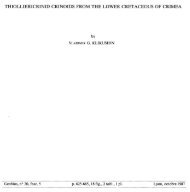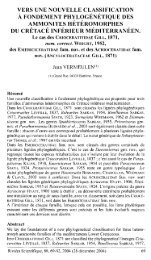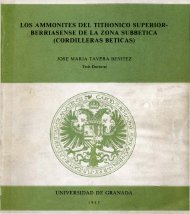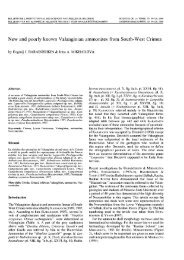peter franklin rawson, dennis curry, frank charles dilley, john michael ...
peter franklin rawson, dennis curry, frank charles dilley, john michael ...
peter franklin rawson, dennis curry, frank charles dilley, john michael ...
You also want an ePaper? Increase the reach of your titles
YUMPU automatically turns print PDFs into web optimized ePapers that Google loves.
formulated:Bostrychoceras polyplocumHoplitoplacenticeras variMenabites (Delawarella) delawarensisDiplacmoceras bidorsatumThe base of the stage is thus currently drawn at the base of the bidorsatum Zone {seeSchmid 1959 for discussion).Recent work on the microfauna of the sections at Aubeterre has shown that thebulk of the type Campanian is actually Maastrichtian as now understood (van Hinte1965; Goharian 1971; Seronie-Vivien 1972). To try to stabilize the meaning ofCampanian, Seronie-Vivien has designated parastratotype sections near Ne in theCharente valley. In spite of this rationalization, it fails to provide us with a workingstandard for the base of the Campanian. Macro-fossils are scarce and not distinctive(Seronie-Vivien 1972, 44-46).Since there are no means of accurate correlation with the type area, and we haveno index ammonites of the lower zones of the stage in Britain, we have followedconvention and placed the base of the Campanian at the base of the assemblagezoneof Offaster pilula. This is taken at the base of the belt of Uintacrinus anglicus inSussex (Bed 5 of Brydone 1915), above the upper limit of Marsupites but 2 m lowerthan the base of the pilula Zone sensu Brydone (1914).The Campanian zones recognized here are:Belemnitella mucronataGonioteuthis quadrataOffaster pilulaIn southern England the pilula Zone has been divided into approximately sevenunits, mainly on the basis of the Echinocorys succession (Griffith & Brydone 1911;Brydone 1912, 1914; Gaster 1924, 1937; summary table by Peake in Hancock1972, p. 114). The quadrata Zone is more difficult to divide, and although it can beattempted with both belemnites and echinoderms, no subzonation is agreed. Themucronata Zone is readily divided into subzones based on Belemnitella andEchinocorys spp. (see Peake & Hancock 1961; Wood 1967; Wood in Manning et al.1970).The MaastrichtianThe Maastrichtian Stage was introduced by Dumont (1850) with the town ofMaastricht designated as type locality. The exact limits of Dumont’s concept of thestage are somewhat ambiguous and have given rise to considerable controversy (seeVoigt 1956, Deroo 1966, for a useful discussion). The stratotype has now been fixedby the Comite d’etude du Maastrichtian as the section of the Tuffeau deMaastricht—i.e. units Ma—Md of Uhlenbroek (1911)—exposed in the ENCI quarryat St. Pietersberg on the outskirts of Maastricht. Thus defined, the type Maastrichtianfalls entirely within the Upper Maastrichtian Substage of current usage (Schmid
















